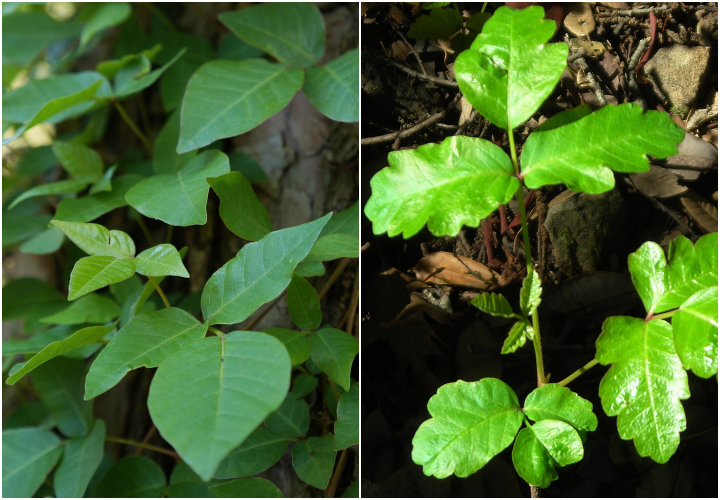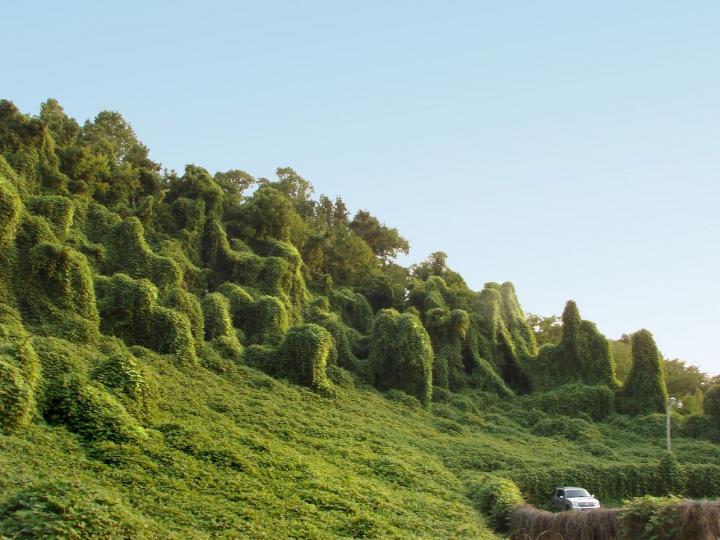Poison ivy, poison oak, kudzu, and mesquite are four of the toughest brush species whose presence on a property goes beyond problematic and into damaging. How do you remove poison ivy and oak quickly? How do you keep invasive kudzu and mesquite from choking plants? Here’s how to get rid of hard-to-kill brush effectively.
Toxic. Aggressive. Invasive. In this article, we’ll address four plants from around North America that need to be removed from our yards, gardens, and property. Out of the thousands and thousands of plant species, it’s rare that plants are so intolerable that we can’t coexist. But protecting children at the playground from poison ivy or protecting valued pollinator trees from smothering kudzu requires serious action.
We’ll discuss why these four plants are so tough to control and also provide easy, inexpensive, and environmentally responsible steps for you to take to remove them. The methods involve spraying a small but potent concentration of herbicide directly on each plant. This procedure allows you to keep the rest of the plants and selectively remove the poisonous or invasive plant. In addition, both people and pets can enter the area once this herbicide spray has dried after application.
How to Safely Remove Poison Ivy and Poison Oak
Thanks to itchy rashes and burning water blisters, many of us are familiar with poison ivy and poison oak which are native throughout different regions of North America. For both species, the rash is caused by a reaction to an oily resin called urushiol (u-ROO-she-ol) which is found in the leaves, stems and roots.
- Poison Ivy (Toxicodendron radicans) is a low-growing shrub or a woody climbing vine which is most prominent in the Midwest. Three leaflets—with smooth or toothed edges—turn reddish in spring, green in summer, and yellow, orange, or red in fall. The leaves can also appear either waxy, shiny, or dull, depending on the time of year and rainfall. Berries are white.
- Poison Oak different plant but contains the same poison: urushiol. Poison oak also has three green leaflets which turn yellow or orange in the fall but the leaves resemble an oak leaf rounded tips; the leaves also have fuzzy hair on both sides. Berries are yellowish or greenish. There are two species of Poison Oak with different geographies (and neither grows in the Midwest):
- Eastern poison oak (Rhus toxicodendron) is a low-growing upright shrub (not climbing) in the northeastern and southern United States.
- Western poison oak (R. diversiloba)is a woody shrub or vine that grows in the Pacific region.

Image: Showing how poison oak leaves (on the right) differ in shape versus poison ivy.
Why Are Poison Ivy and Poison Oak So Tough to Control?
These woody plants grow amongt shrubs and ground covers, quickly reproducing by spreading via underground rhizomes and seeds. Plus, vines have aerial rootlets that attach to whatever the vine may be growing on. Birds and other wildlife eat the berries and spread the seeds in their droppings, which is how poison ivy and poison oak usually get started in the landscape.
- Repeatedly cutting the plant back to the ground may eventually starve the plant. However, each time you cut it, you expose yourself to the toxic leaves.
- Yes, you can dig up and discard small plants. However, if you leave behind any portion of the root system, the plant will likely resprout.
- You can NOT burn poison ivy. This can be extremely hazardous because the smoke contains the oils which, when inhaled, cause serious injury to your eyes, skin, and respiratory system.
How to Get Rid of Poison Ivy and Poison Oak
The best solution for getting rid of both poisonous plants is to apply an herbicide directly to the plant itself. Products with the active ingredient triclopyr are the most effective at total eradication.
Timing is important. Apply in spring to early summer when plants are in full-leaf stage, using a hand sprayer with a pump (or backpack sprayer for larger properties). Thoroughly spray the leaves and vegetative parts of the plant. Even better, cut down the poison ivy or oak to the stem or stump and apply in early spring or fall. This is a more targeted approach. Definitely spot-treat the stems or stumps if you have desirable plants nearby that you wish to keep alive. Also, keep in mind that herbicides are for noncrop areas.
Learn more about solutions for poison ivy and poison oak, including solutions for large properties.
How to Kill Kudzu
This extremely invasive perennial vine grows at a rate of 1 foot per day, with mature vines reaching lengths of up to 100 feet! Kudzu (Pueraria lobata) can overtake any plant or structure in its path, often engulfing entire trees. It’s especially invasive in the southern United States, which has the temperate climate of its native Asia.
Kudzu has alternating leaves made of three oval-shape or lobed leaflets. After 3 years, it produces purple or red flowers that are edible. Imported innocently from Asia as an ornamental plant to reduce soil erosion on hillsides, kudzu has become an out-of-control scourge on the landscape. The U.S. Forest Service estimates that kudzu is overtaking over 2,500 acres per year. The Department of Agriculture estimates far more destruction, which has been extremely costly for farmers and property owners

Image: Invasive kudzu smothers trees in Blount County, Tennessee. © Katie Ashdown via Flickr (CC BY 2.0)
Why Is Kudzu So Tough to Control?
Known as “mile-a-minute” and “the vine that ate the South,” kudzu spreads incredibly rapidly through a combination of runners, rhizomes, and vines that root at the nodes to form new plants. From any node, kudzu extends stems or tendrils to attach to and climb any surface.
Kudzu’s primary method of reproduction is asexual vegetative spread (cloning), which is aided by the ability to root wherever a stem is exposed to soil. With its pace of growth (1 foot per day) and massive root system, kudzu has an exponential growth that outcompetes native plants.
Kudzu pushes out everything from native grasses to fully mature trees by shading them from the sunlight that they need to photosynthesize. The loss of native plants translates to a virtual desert of biodiversity, leading to insect, bird, and species declines.
How to Get Rid of Kudzu in the Yard and Garden
- For new and small patches of kudzu, it’s possible to cut back or mow. However, it requires continuous mowing and cutting back (and grazing if you have cattle or goats) for the plant to weaken. This can be extremely time-consuming. In addition, the vine has to be completely destroyed or else it will simply root and regrow.
-
For larger growths or for a less time-consuming option, the most effective control is an herbicide with triclopyr. Because this can be expensive, the vines should be cut near the ground and then carefully treated with herbicide. For the most effective solution, apply in late summer when the plants are more susceptible to transferring the chemicals into storage organs.
See solutions for getting rid of kudzu effectively.
How to Beat Mesquite
Moving to the south-central United States, we have the mesquite tree (Prosopis glandulosa Torr.), one of the toughest invasive brush species that exists. It’s been called “the devil with roots”—the thorny bane of cattle, horses, and cowhands. The range of mesquite covers nearly 2.5 million acres of land across the U.S. and Mexico, extending from northern Mexico all the way through Kansas. In Texas, an estimated 25% of the state’s grasslands are infested.
Though mesquite was native to creek bottoms and watershed areas, it has invaded grasslands and pastures due to the introduction of domestic livestock that eat and spread the seeds, increased control of wildfires, droughts, and overgrazing. Deep-rooted with thorns, this small tree loves water; a single tree can consume nearly 21 gallons of water per day. By sponging up all of the groundwater, mesquite lowers the water table, causing all nearby vegetation to die, make watering holes inaccessible to animals, and even affect watersheds, which impacts lake water levels and the very water necessary for life to survive.
About 20 to 30 feet tall and thorny, mesquite has one or more trunks with many branches and a crown of bipinnate leaves that cast a light dappled shade. It forms 2-inch spiky thorns as well as spikes of fragrant white flowers in the spring. By summer, long edible beanpods hang from the tree.

Image: Texas honey mesquite tree. Credit: Eugenie Robitaille/Shutterstock.
Why Is Mesquite So Hard to Control?
Today, rural pastures are completely polluted with mesquite. Mesquite has very deep tap roots that reach down 200 feet. These roots not only reach down deep but also spread 50 feet outside the tree canopy.
Livestock and wildlife eat the fruit or “pods” of mesquite trees, which causes the seed to be spread all across rural pastures and grazed land. Young seedlings spring up everywhere. Each pod contains 10 to 30 seeds and can lie dormant in the soil for several years.
In addition, mesquite can adapt to almost any type of soil, adapts to sun or shade, has low water requirements, and can live in very high heat. In drought, mesquite still thrives, sucking every last drop of water from nearby native grasses. Once mesquite invades, it’s almost impossible to to get rid of it. Its thorns are dangerous to livestock as well.
How to Get Rid of Mesquite in the Yard and Garden
Mesquite can be removed by mechanical control, although its deep roots necessitate bulldozing to uproot the trees, which is often cost-prohibitive. Most landowners spray the stumps or leaves with a handheld or backpack sprayer, a technique that has a 90% rate of success. Some folks do both by using mechanical control to get rid of the bush and tree and applying heavy mulch and herbicide to the tree stump. If you do not spray the tree, however, additional cutting will be needed to clean future regrowth.
The Cooperative Extension services at Texas A&M AgriLife and New Mexico State University offer two ways to spray directly on the plant:
- Spraying stems: For small, young mesquite trees that have a few basal stems or trunks emerging from the ground and smooth bark, spray the plant’s trunk from the ground line to 12 inches up the stem. This method is known as the “low volume basal stem technique” and uses very little herbicide per plant. Research has shown excellent results from using much less herbicide, which makes this approach economical and environmentally-responsible. Apply the mixture to all sides of the trunk, wetting the plant almost to the point of runoff. (Only stems less than 4 inches in diameter should be sprayed.) A benefit of the low volume basal stem technique is that it can be used at any time of year, although best results occur during the spring–summer growing season when temperatures are high.
- Spraying leaves: If your mesquites are bushy, less than 6 to 8 feet tall, and have many stems at ground level, try the leaf spray method. This method is also known as “high-volume foliar spraying.” When spraying the leaves, wait until the soil temperature has reached 75 degrees F at 12 inches deep and after the mesquite leaves have changed color from a light pea green to a uniform dark green color. In some areas, this may be closer to June. On a dry day, spray all leaves until they glisten and are wet, but not to the point of dripping. Spraying may continue throughout the summer until seedpods have fully matured.
Learn more about Brush Killer solutions that get rid of hard-to-kill mesquite.
No matter which part of the U.S. you’re in, you can find pest solutions tailored to your part of the country here.
